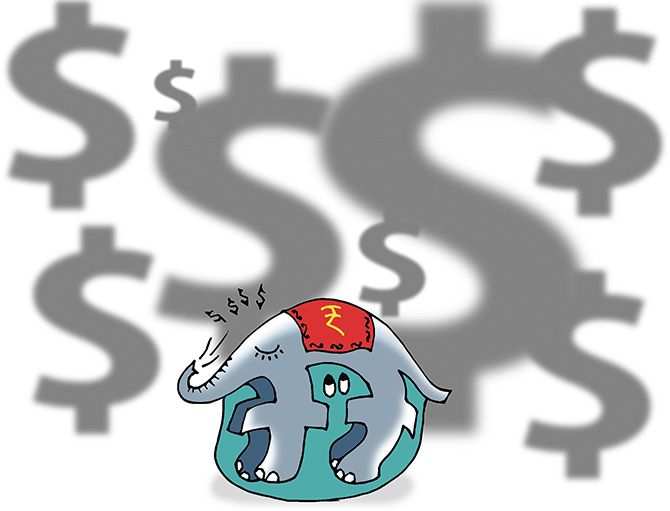India’s total hard currency debt as of end March 2019 was $ 543 billion of which $ 235.7 billion, debt with residual maturity of one year and due for repayment by end March 2020, amounts to 56 per cent of FX reserves.
Such a high proportion of short-term debt highlights India’s vulnerability to any protracted reduction in FX inflows.
This risk metric needs to be kept in mind when considering the issuance of sovereign hard currency bonds.
Any future decision to issue sovereign bonds should be linked to an improvement in the India’s credit rating to single A along with further opening up of the capital account, says Jaimini Bhagwati.
Part 1: India's exchange rate policies are flawed
Illustration: Dominic Xavier/Rediff.com

The announcement in the latest Budget of the central government’s intention to borrow $10 billion from international capital markets through sovereign bonds was a startling revelation.
Such off-shore bond issuance would purportedly be in lieu of domestic borrowings.
To that extent it would lead to less crowding out of non-government borrowers from domestic financial markets.
A number of commentaries have appeared in the media including one on July 26 indicating that perhaps the Prime Minister’s Office is opposed to this Ministry of Finance's (MoF) proposal to issue sovereign hard currency bonds.
According to some media reports, it was lobbying by investment banks which convinced MoF to take this decision.
Investment bankers have lobbied with MoF officials in the past to issue such bonds.
I can confirm this from my personal experience as joint secretary (capital markets) in the Department of Economic Affairs in 1999.
At that time there was concern about shortage of hard currency in the run up to potential Y2K problems.
The arguments against government issuance of hard currency bonds prevailed on the grounds that it may become a habit and could lead to a sovereign debt crisis.
The MoF finally decided to authorise State Bank of India to issue five year India Millennium Deposits (IMDs) amounting to $ 5 billion.
The all-in-cost of those hard currency deposits marketed to NRIs was about 100 basis points more than the proposed sovereign bonds of the same maturity.
The logic put out by current proponents of sovereign hard currency bonds is that given the ultra-low interest rates in hard currencies, the government should be able to issue bonds amounting to $ 10 billion at maturities of up to 30 years at low interest rates.
A better benchmark to assess whether India’s cost of borrowing abroad would be the spread to a floating rate index such as six month LIBOR not absolute rates of interest.
Although $ 10 billion of debt should be relatively easy to access from international markets, it is less obvious that foreign creditors would be willing to provide 30-year money.
And, interest rates on government bonds trading in domestic markets would go up if spreads on proposed sovereign bonds were to rise with respect to bonds issued by developed countries.
At the end June 2019, the RBI’s foreign exchange (FX) reserves amounted to about $ 422 billion.
This is around 15 per cent of GDP way below the 26 per cent of GDP level of FX reserves in 2007-08.
India’s total hard currency debt as of end March 2019 was $ 543 billion of which $ 235.7 billion, debt with residual maturity of one year and due for repayment by end March 2020, amounts to 56 per cent of FX reserves.
Such a high proportion of short-term debt highlights India’s vulnerability to any protracted reduction in FX inflows.
This risk metric needs to be kept in mind when considering the issuance of sovereign hard currency bonds.
Multilateral development financial institutions such as IBRD and IFC and Indian sub-sovereigns such as NTPC and HDFC Bank have issued rupee masala bonds to investors based outside India.
Foreign investors in such bonds are prepared to take the currency risk of investing in Indian rupee denominated bonds.
The Indian sovereign could access this market to borrow rupees from international investors rather than taking the foreign exchange risk of issuing hard currency bonds.
On the downside, masala rupee bonds could reduce investments in Indian government debt which comes via foreign portfolio investors (FPIs).
Further, the interest rates on masala rupee bonds may need to be higher than on government’s domestically issued bonds for the same maturities.
Foreign investors would probably want masala bonds to be traded in secondary markets much in the same way as government bonds are traded domestically.
Lead managers of masala bonds would need to include the cost for making secondary markets raising the cost of issuing such bonds.
The rupee is currently hugely overvalued.
Bringing in hard currency through sovereign bonds would be a net addition since this route has not been used in the past.
At the margin this would exacerbate rupee appreciation.
The current overvaluation of the rupee is mostly a reflection of India’s need to access foreign capital to make up for inadequate domestic savings.
Consequently, some may argue that the only way to reduce rupee overvaluation is by compressing consumption and investment and that may not be feasible or appropriate.
Another way to correct rupee overvaluation is to gradually relax controls on capital account convertibility.
If the government decides it can borrow from international sources using sovereign bonds, the country should be able to reduce controls on the capital account.
An objective yardstick would be a higher sovereign credit rating.
The major rating agencies such as Standard & Poor’s and Moody’s are at arms-length from the Indian government even if they were not with respect to US financial institutions prior to the financial sector meltdown of 2008.
The point repeatedly stressed by several commentators is that if sovereign bonds are issued in limited quantities there is no danger of a hard currency debt crisis at a later date.
Dr Y V Reddy, former RBI governor, has suggested in a recent column that issuance of sovereign hard currency bonds could be linked to steps towards capital account convertibility.
This is an eminently practical and technically appropriate suggestion. $ 10 billion is neither here nor there in terms of the amounts required to recapitalise public sector banks or fund pending infrastructure projects.
In this context, the MoF should provide a white paper to Parliament on where the country is in its glide path towards greater capital account convertibility.
Standard & Poor’s current sovereign rating for India is triple BBB minus.
To conclude, any future decision to issue sovereign bonds should be linked to an improvement in the India’s credit rating to single A along with further opening up of the capital account.
Jaimini Bhagwati is a former government of India and World Bank professional.












 © 2025
© 2025